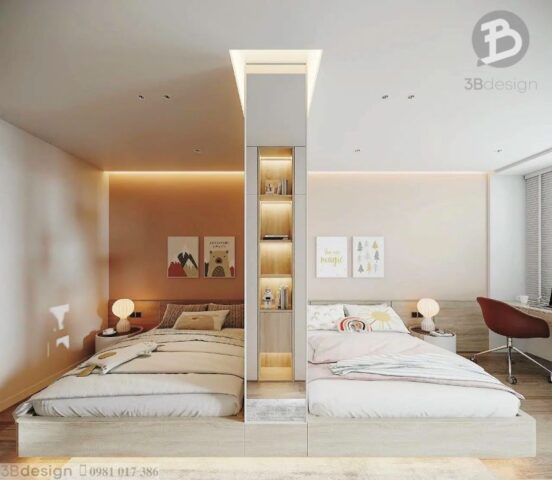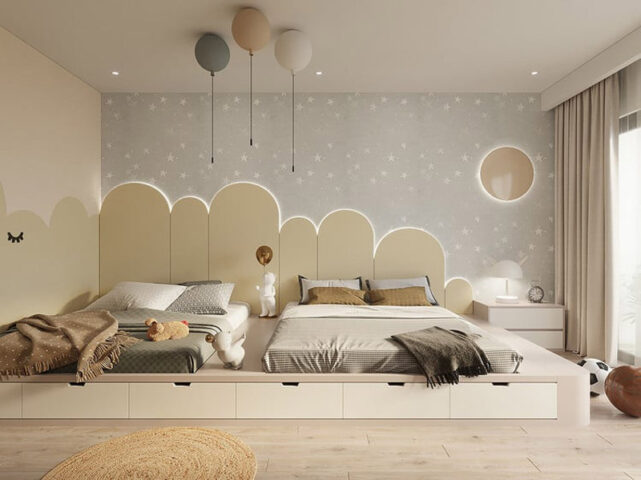Contents
- Understanding Official Guidelines on Room-Sharing Duration
- The American Academy of Pediatrics (AAP) Stance: Minimum 6 Months, Ideally 1 Year
- Global Health Organizations’ Perspectives: WHO and NHS Recommendations
- The Critical Benefits of Room-Sharing for Infants
- Significantly Reducing the Risk of SIDS (Sudden Infant Death Syndrome)
- Facilitating Easier Nighttime Feedings and Diaper Changes
- Enhancing Parent-Infant Bonding and Attachment
- Enabling Quicker Parental Response to Baby’s Needs
- Distinguishing Room-Sharing from Bed-Sharing: Safety First
- Why Bed-Sharing Is Not Recommended by Health Experts
- Creating a Safe Sleep Environment in the Parents’ Room
- When and How to Transition Your Baby to Their Own Room
- Recognizing Developmental Readiness for Independent Sleep
- A Gradual Approach to Moving the Crib
- Establishing a Consistent Bedtime Routine for New Environments
- Optimizing the Shared Sleep Space for Safety and Comfort
- Essential Safe Sleep Practices in the Parents’ Room
- Maintaining an Ideal Room Temperature and Darkness
- Minimizing Noise and Disturbance in the Shared Room
- Addressing Common Parental Concerns and FAQs
- What If Room-Sharing Disrupts Parental Sleep?
- Is There a Risk of Baby Becoming Too Dependent?
- Navigating Different Recommendations and Personal Choices
Deciding how long should babies sleep in your room is a significant decision for new parents. Room-sharing, where a baby sleeps in the same room as parents but in their own separate safe sleep space, offers numerous benefits. This practice is strongly endorsed by leading health organizations worldwide, primarily for SIDS prevention and promoting parental bonding. Understanding the guidelines and reasoning behind these recommendations can help foster a secure and healthy sleep environment for your infant. It is essential to prioritize safe sleep practices from day one.
Understanding Official Guidelines on Room-Sharing Duration
Leading health organizations provide clear recommendations on how long should babies sleep in your room. These guidelines are based on extensive research aimed at promoting infant safety and healthy development. Adhering to these expert recommendations helps parents make informed choices. The goal is always to create the safest possible sleep environment for the baby.
The American Academy of Pediatrics (AAP) Stance: Minimum 6 Months, Ideally 1 Year
The American Academy of Pediatrics (AAP) is a leading authority on infant health. The AAP updated its safe sleep recommendations in 2022, strongly advocating for infants to sleep in the parents’ room. This practice should continue for at least the first six months, and optimally for the first year of life. This recommendation is a cornerstone of SIDS prevention strategies. It emphasizes proximity without compromising safety.
The AAP stresses that infants should sleep in a separate sleep surface. This means a crib, bassinet, or play yard, placed in the parents’ bedroom. This setup allows for easy monitoring and feeding. Simultaneously, it prevents the dangers associated with bed-sharing. Parents can respond quickly to their baby’s needs.
Global Health Organizations’ Perspectives: WHO and NHS Recommendations
Beyond the AAP, other reputable global health organizations echo similar sentiments. The World Health Organization (WHO) supports room-sharing as a key strategy. It promotes breastfeeding and facilitates quick parental intervention. These guidelines are consistent across various cultures. They reflect a universal understanding of infant care.
Similarly, the UK’s National Health Service (NHS) advises room-sharing for at least the first six months. The NHS highlights the protective effect against Sudden Infant Death Syndrome (SIDS). Both organizations underline that a baby’s crib should be close to the parents’ bed. This proximity allows for constant supervision. This collective endorsement reinforces the global consensus.
The Critical Benefits of Room-Sharing for Infants
Room-sharing offers profound advantages for infant health and development. These benefits extend beyond just safety. They contribute to a baby’s overall well-being. Parents also experience greater peace of mind knowing their baby is close.
Baby sleeping peacefully in a bassinet next to a parent's bed, illustrating safe room-sharing practices
Significantly Reducing the Risk of SIDS (Sudden Infant Death Syndrome)
One of the most compelling reasons for room-sharing is its proven role in reducing the risk of SIDS. The AAP estimates room-sharing can reduce SIDS risk by up to 50%. This significant reduction is attributed to several factors. Proximity allows parents to hear and respond to their baby. This includes changes in breathing or distress signals.
A parent’s presence also helps regulate the baby’s sleep patterns. Babies tend to rouse more frequently when parents are nearby. This may prevent them from entering overly deep sleep states. Deep sleep is sometimes linked to SIDS risk. The constant, subtle sounds and movements of parents create a stimulating environment.
Facilitating Easier Nighttime Feedings and Diaper Changes
Nighttime feedings are a frequent occurrence for infants, especially newborns. Room-sharing significantly simplifies this routine. Parents do not need to leave their room to feed or change diapers. This convenience is invaluable for sleep-deprived parents. It promotes more consistent feeding schedules.
Being close means less disruption for both parent and baby. The baby can be picked up, fed, and returned to their crib with minimal effort. This efficiency helps babies return to sleep more quickly. It supports continued healthy weight gain and development.
Enhancing Parent-Infant Bonding and Attachment
The close proximity afforded by room-sharing fosters a strong bond between parents and infants. This continuous interaction, even during sleep, strengthens attachment. Parents are more attuned to their baby’s cues. They learn to interpret their baby’s sounds and movements. This deepens their emotional connection.
This enhanced bonding is crucial for a baby’s emotional development. Secure attachment provides a foundation for future relationships. It helps the baby feel safe and loved. Many parents report feeling more connected to their baby.
Enabling Quicker Parental Response to Baby’s Needs
Having the baby in the same room ensures parents can respond immediately to their needs. This includes crying, fussing, or signs of discomfort. Quick responses are vital for meeting a baby’s basic requirements. It also offers reassurance to a distressed infant. Prompt attention can prevent minor issues from escalating.
This immediate responsiveness contributes to a baby’s sense of security. They learn that their caregivers are reliably present. This builds trust and confidence in their environment. It makes both parents and babies feel more secure.
Distinguishing Room-Sharing from Bed-Sharing: Safety First
It is crucial to understand the clear distinction between room-sharing and bed-sharing. While both involve proximity, their safety profiles are vastly different. Health organizations strongly endorse room-sharing. Conversely, they advise against bed-sharing due to significant risks. This distinction is critical for infant safety.
Why Bed-Sharing Is Not Recommended by Health Experts
Bed-sharing, where an infant sleeps in the same bed as parents or other children, poses serious safety risks. These risks include accidental suffocation, strangulation, and entrapment. The AAP, WHO, and NHS uniformly advise against bed-sharing. They highlight its association with an increased risk of SIDS. The CDC also reports bed-sharing as a factor in numerous infant sleep-related deaths.
Parents might accidentally roll onto the baby during sleep. Soft bedding, pillows, and blankets can also obstruct a baby’s airway. These dangers are present even in seemingly safe situations. The benefits of proximity can be achieved safely through room-sharing.
Creating a Safe Sleep Environment in the Parents’ Room
Establishing a safe sleep environment is paramount when babies sleep in your room. The baby should always sleep alone, on their back, in a crib, bassinet, or play yard. This sleep surface must meet current safety standards. It should have a firm mattress. The mattress must be covered by a fitted sheet.
Ensure there are no loose blankets, pillows, bumpers, or toys in the sleep space. These items can pose suffocation hazards. The room temperature should be comfortable, not too warm. Avoid overdressing the baby. A sleep sack or wearable blanket is a safe alternative to loose blankets.
When and How to Transition Your Baby to Their Own Room
The decision of when to move a baby to their own room is personal. However, it should align with safety recommendations and developmental readiness. While the AAP suggests keeping baby in your room for up to a year, many parents consider transition earlier. This transition can be a smooth process with careful planning.
Recognizing Developmental Readiness for Independent Sleep
Pediatric sleep experts, such as Dr. Sarah Smith from the National Sleep Foundation, suggest that signs of readiness for independent sleep often emerge between 6-12 months. These signs include improved self-soothing abilities. The baby might also start sleeping for longer stretches through the night. Observe your baby’s unique sleep patterns.
Some babies may show discomfort with parental presence affecting their sleep. Others might wake more frequently due to parental noise or movement. These are cues that a transition might be beneficial. Trust your parental instincts alongside expert advice.
A Gradual Approach to Moving the Crib
A gradual approach often works best for transitioning a baby to their own room. Start by spending short periods in the baby’s room during the day. Let them play and become familiar with the space. Gradually move the crib further away from your bed within your room. This can be a first step towards separation.
Then, try moving the crib into the baby’s room for naps. Once they are comfortable with naps, introduce nighttime sleep in their own room. Maintain consistency in your bedtime routine. This predictability helps ease the transition.
Establishing a Consistent Bedtime Routine for New Environments
A consistent bedtime routine is crucial, especially during transitions. This routine signals to the baby that it’s time for sleep. It can include a warm bath, a gentle massage, reading a story, or singing a lullaby. The routine should be calm and predictable.
Perform this routine in the baby’s new room. This helps them associate the space with comfort and sleep. Ensure the room is dark, quiet, and at a comfortable temperature. These environmental cues are essential for successful independent sleep.
Optimizing the Shared Sleep Space for Safety and Comfort
Creating an optimal shared sleep space involves more than just placing a crib in the room. It requires careful consideration of safety, comfort, and environment. These factors are critical for both baby’s and parents’ well-being. A well-optimized space promotes better sleep for everyone.
Parent gently checking on a baby sleeping in a crib next to their bed, demonstrating attentive room-sharing
Essential Safe Sleep Practices in the Parents’ Room
Beyond the basics, maintaining vigilance with safe sleep practices is non-negotiable. Always place your baby on their back to sleep. Ensure the sleep surface is firm and flat. Avoid inclined sleepers or car seats for routine sleep. These practices are consistent whether room-sharing or in their own room.
Remove any objects that could potentially obstruct breathing. This includes cords from blinds or curtains. Position the crib away from windows to avoid temperature fluctuations. Regularly check the crib for any loose parts or damage.
Maintaining an Ideal Room Temperature and Darkness
The room temperature plays a crucial role in infant sleep safety and comfort. Overheating is a known risk factor for SIDS. Aim for a comfortable temperature between 68 and 72 degrees Fahrenheit (20-22 degrees Celsius). Use a room thermometer to monitor. Dress your baby in light sleepwear.
Darkness signals to a baby’s body that it’s time to sleep. Use blackout curtains to block out external light. This helps establish a healthy circadian rhythm. A dim nightlight can be used for nighttime feedings and changes. Ensure it doesn’t disrupt sleep.
Minimizing Noise and Disturbance in the Shared Room
While parental sounds can be protective against SIDS, excessive noise can disrupt infant sleep. Try to minimize loud noises, conversations, and TV volume. If your baby is a light sleeper, consider using a white noise machine. White noise can mask sudden sounds.
Parents should also be mindful of their own movements and sleep patterns. Adjusting personal habits slightly can greatly benefit the baby’s sleep quality. Creating a serene and peaceful atmosphere is key. This helps both baby and parents achieve restorative sleep.
Addressing Common Parental Concerns and FAQs
Parents often have questions and concerns regarding room-sharing. It’s natural to seek reassurance and practical advice. Addressing these common issues helps alleviate anxieties. It empowers parents to make choices that fit their family’s unique situation.
What If Room-Sharing Disrupts Parental Sleep?
While room-sharing offers significant benefits, some parents worry about disrupted sleep. A 2023 study published in ‘Pediatrics’ indicated that while room-sharing might slightly impact parental sleep quality initially, the overall benefits for infant safety and parental peace of mind outweigh this. It’s a balance between parental rest and infant safety.
Strategies to minimize disruption include using a white noise machine. Parents can also adjust their bedtime to match the baby’s. Some parents find earplugs helpful for light sleepers, as long as they can still hear the baby’s cries. Prioritizing consistent routines for both parents and baby is crucial.
Is There a Risk of Baby Becoming Too Dependent?
A common concern is whether room-sharing fosters excessive dependence. Expert consensus suggests that room-sharing, especially in the first year, builds a secure attachment. This security actually promotes greater independence later on. Babies who feel secure are often more confident.
The first year is a critical period for attachment. Meeting a baby’s needs promptly during this time fosters trust. It doesn’t create unhealthy dependence. As babies grow, they naturally develop a desire for more independent sleep. This typically happens when they are developmentally ready.
Navigating Different Recommendations and Personal Choices
Parents might encounter varying advice from different sources or cultural backgrounds. It’s important to consult with your pediatrician. They can provide personalized guidance based on your baby’s health and your family’s circumstances. Rely on evidence-based recommendations from reputable health organizations.
Ultimately, the decision of how long should babies sleep in your room involves balancing expert guidelines with personal family dynamics. Prioritize safe sleep practices above all else. Make informed choices that support both your baby’s development and your family’s well-being.
Establishing safe sleep practices and making informed decisions about how long should babies sleep in your room are vital for infant well-being. Room-sharing, in a separate safe sleep space, aligns with expert recommendations from organizations like the AAP and WHO. This practice significantly reduces SIDS risk, facilitates care, and strengthens parent-infant bonds. While parental sleep might be a consideration, the overwhelming benefits for safety and parental well-being make it a highly recommended approach for at least the first six months, ideally up to a year.
Last Updated on October 16, 2025 by Dr.BaBies

Dr. BaBies is our expert consultant focusing on the health and well-being aspects of early childhood screen exposure. Holding a doctorate in Developmental Health, Dr. BaBies specializes in understanding the impact of visual and auditory stimuli on a baby’s developing nervous system and sleep patterns.




